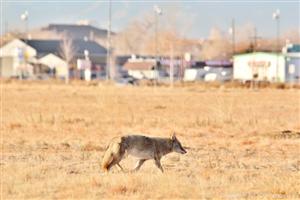 You can go practically anywhere in the state and see that Colorado’s population is booming. The I-25 corridor, including Fort Collins, Colorado Springs, and the Denver Metropolitan Area, is especially seeing record growth. More people results in more development, which equals changes and/or reduction in habitat for wildlife. Therefore wildlife numbers are reduced, and many of those that survive are wandering into urbanized areas. Predatory animals such as bears, mountain lions, and coyotes have become more dangerous to people and pets due to the building of homes in the animals’ natural habitats. Other wildlife, such as prairie dogs, are being eliminated at fast pace. Wildlife species are important to our ecosystem, and the loss of their habitat will bring continued changes and ever more frequent interactions with humans. Not only does building development reduce wildlife habitat, but more roadways and traffic, human-caused wildfires, resource extraction, and other situations are hazardous to wildlife as well. Here are some resources from our library that discuss this trend, and how humans can deal with wildlife interactions in the interest of both human and animal safety. All publications are issued by the Colorado Division of Wildlife (now Colorado Parks & Wildlife) unless otherwise noted. For more resources, visit our library’s online catalog.
You can go practically anywhere in the state and see that Colorado’s population is booming. The I-25 corridor, including Fort Collins, Colorado Springs, and the Denver Metropolitan Area, is especially seeing record growth. More people results in more development, which equals changes and/or reduction in habitat for wildlife. Therefore wildlife numbers are reduced, and many of those that survive are wandering into urbanized areas. Predatory animals such as bears, mountain lions, and coyotes have become more dangerous to people and pets due to the building of homes in the animals’ natural habitats. Other wildlife, such as prairie dogs, are being eliminated at fast pace. Wildlife species are important to our ecosystem, and the loss of their habitat will bring continued changes and ever more frequent interactions with humans. Not only does building development reduce wildlife habitat, but more roadways and traffic, human-caused wildfires, resource extraction, and other situations are hazardous to wildlife as well. Here are some resources from our library that discuss this trend, and how humans can deal with wildlife interactions in the interest of both human and animal safety. All publications are issued by the Colorado Division of Wildlife (now Colorado Parks & Wildlife) unless otherwise noted. For more resources, visit our library’s online catalog.
- An Assessment of Imperiled Habitat in Colorado (Colorado State University)
- Be Bear Aware in Colorado Bear Country
- Beliefs and Attitudes Toward Urban Wildlife (Colorado State University)
- Conservation Plan for Grassland Species in Colorado
- Crucial Habitats and Corridors
- Developing with Wildlife in Mind
- Don’t Tempt with Twinkies: Wildlife and People at Risk
- Effects of Population Growth on Wildlife Habitat in Colorado
- Estimating Impacts of Highway Projects on Select Rare, Sensitive, or Declining Species on Colorado’s Central Shortgrass Prairie (Colorado State University)
- Essential Habitat for Threatened or Endangered Wildlife in Colorado
- Evaluation of Fertilizer and Herbicide Applications on Two Colorado Bighorn Sheep Winter Ranges
- Federal Threatened and Endangered Species and Habitat Conservation (Colorado Legislative Council)
- Fencing with Wildlife in Mind
- Habitat Crisis
- I-70 Wildlife Watch (Colorado Department of Transportation)
- Managing Development for People and Wildlife: A Handbook for Habitat Protection by Local Governments
- Living with Bears
- Living with Deer and Elk
- Living with Wildlife: Canada Geese
- Living with Wildlife in Bear Country
- Living with Wildlife in Coyote Country
- Living with Wildlife in Lion Country
- Living with Wildlife in Moose Country
- Living with Wildlife in Red Fox Country
- Mitigation of Impacts to Mule Deer and Elk from Energy Development in Northwest Colorado
- Monitoring Wildlife-Vehicle Collisions (Colorado Department of Transportation)
- Mountain Lion-Human Interaction
- Prairie Dog Management and Wildlife Protection
- Protecting Critical Wildlife Habitat in Land Development (videocassette)
- Recommended Survey Protocol and Actions to Protect Nesting Burrowing Owls
- Status Report on Efforts to Address Impacts of Oil and Gas Operations on Wildlife Habitat (Colorado Oil and Gas Conservation Commission)
- Taking a Look at Urban Wildlife
- Too Close for Comfort: How to Avoid Conflicts with Wildlife in the City
- Urban Wildlife
- Urban Wildlife: Planning for the Future (videocassette)
- Wild in the Streets: Denver Area Wildlife Adjusts to Urban Living
- Wildlife in Danger
- Wildlife in Danger (videocassette)
- Wildlife Habitat Losses to Development in Teller and El Paso Counties, Colorado (University of Colorado – Colorado Springs)
- Your Guide to Avoiding Human-Coyote Conflicts
- How to Spot the Differences Between Eagles and Hawks - August 16, 2021
- How Transportation Projects Help Tell the Story of Colorado’s Past - August 9, 2021
- Time Machine Tuesday: The Night the Castlewood Canyon Dam Gave Way - August 3, 2021